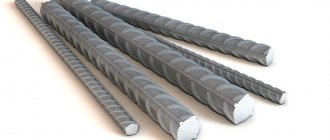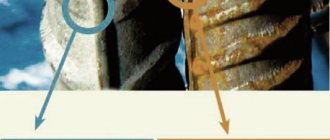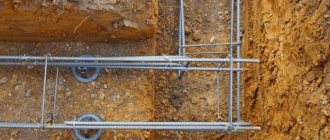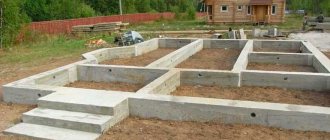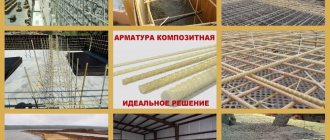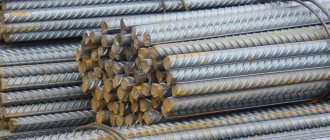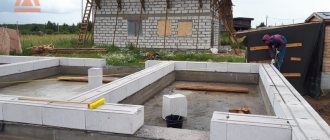Correctly calculated overlap of reinforcement during tying affects the final quality of the structure. The reliability of this method is difficult to challenge, however, there are certain nuances in the work process, if not observed, the result of the connection may turn out to be fragile and short-lived. This can also affect the rate at which the concrete hardens, causing the base to become very soft.
Why is it necessary to comply with reinforcement overlap standards when knitting?
When pouring the foundation of a house or when erecting any other concrete structure (column or monolithic block), the issue of strength and durability of the structure remains pressing. Subject to compliance with all building codes, an additional metal frame will greatly strengthen the structure and make it durable, and the base unaffected by natural conditions and time.
If the rules are not followed, the foundation of the house may soon collapse, which will lead not only to the loss of a large amount of materials, but also to human casualties. This is due to the fact that incorrectly calculated overlap of reinforcement leads to non-hardening of concrete in some places, which leads to weakening of the entire structure as a whole. To build a strong and reliable frame, several methods are used, including knitting, for which it is necessary to use an overlap.
Requirements of regulatory documents for reinforcement connections
When connecting rods using the knitting method, it is important to consider a number of factors:
- relative arrangement of reinforcement in the spatial frame;
- features of placement of areas with overlap relative to each other;
- the length of the overlap section, determined by the cross-section of the rod and the grade of concrete.
When locating a section with overlapping rods in the zone of maximum load, the amount of overlap should be increased to 90 times the diameter of the rods being connected. Building codes clearly indicate the dimensions of joint areas.
The length of the joint is affected not only by the cross-sectional diameter, but also by the following points:
- magnitude of the effective load;
- brand of concrete mixture used;
- class of steel reinforcement used;
- placement of butt joints in the spatial frame;
- purpose and scope of reinforced concrete products.
It should be noted that the amount of overlap decreases with increasing grade of concrete used.
In cases where tying wire is used, the distance between the rods is often taken equal to zero, since in this situation it depends solely on the height of the profile protrusions
Let's consider the change in the amount of overlap that takes up compressive loads for class A400 reinforcement with a diameter of 25 mm:
- for concrete grade M250, the rods are fixed with a maximum overlap of 890 mm;
- concreting the reinforcing grid with M350 mortar makes it possible to reduce the overlap to 765 mm;
- as the grade of concrete used increases to M400, the overlap of the rods decreases to 695 mm;
- Filling the reinforcement frame with concrete mortar M450 allows you to reduce the overlap to 615 mm.
To reinforce the tension zone of the reinforcement cage, the overlap for the specified reinforcement is increased and amounts to:
- 1185 mm for M200 concrete;
- 1015 mm for concrete M350;
- 930 mm for M400 concrete;
- 820 mm for M450 concrete.
When carrying out activities related to reinforcement, it is important to correctly position the overlap areas and take into account the requirements of building codes and regulations.
The following recommendations should be followed:
- distribute connections evenly throughout the reinforcement frame;
- maintain a minimum distance between joints of at least 610 mm;
- take into account the brand of concrete mortar and the cross-section of reinforcing bars.
Compliance with the requirements of building codes guarantees the strength and reliability of concrete structures reinforced with a reinforcing frame. Having studied the recommendations of SNiP in detail, it is easy to independently select the required amount of reinforcement overlap, taking into account the design features of the reinforced concrete product. Recommendations from professional builders will help you avoid mistakes.
The amount of overlap when connecting reinforcement according to SNIP
The Sanitary Standards and Rules of 2003 (abbreviated SNiP) describe all types of fittings connections that currently exist. Overlapping joints are created without the use of welding machines, in this they differ from mechanical (for which couplings and special equipment are used) and welded (for which a welding machine is respectively required). There are three types of overlap joints:
- Rods with hooks and claws (bends) at the ends.
- Rods with a straight end (with welding or installation at the intersection of reinforcement).
- Rods with straight ends (profile).
The Sanitary Standards and Rules of 2003 recommend overlapping reinforcement with a cross-section of up to 40 mm. In turn, the world analogue of building codes, namely ACI 318-05, states the maximum permissible value of the cross-section of the rods is 36 mm. This is due to the lack of evidence base for the reliability of connections of larger diameter, since no tests have been carried out. Also during knitting, it is worth leaving a certain free space around the overlap.
It must be taken into account that the minimum distance that must be left for reserve, both horizontally and vertically, is 25 mm. However, if the cross-section of the reinforcement itself is more than 25 mm, then the margin must be calculated according to the diameter step. The largest distance between elements is 8 sections of the rod. But when using wire in knitting, the distance is reduced to 4 sections.
It is not recommended to use tying in areas of greatest pressure, since the joint is not designed for such loads, but only for fastening the reinforcement and maintaining them as a single structure.
Overlapping reinforcement connection without welding when installing an armored belt
Using rods marked A400 AIII, which are popular in construction, it is easy to overlap the reinforcement using annealed knitting wire.
SNiP contain recommendations for tying reinforcement and provide various options for connecting rods:
- connection with overlap of straight ends of reinforcing bars;
- fixation of overlapping rods using additional reinforcement elements;
- tying rods with ends curved in the shape of peculiar loops or hooks.
Using knitting wire, it is possible to connect reinforcement with a profile section with a diameter of up to 4 cm. The amount of overlap increases in proportion to the change in the diameter of the rods. The amount of overlap of rods increases from 25 cm (for rods with a diameter of 0.6 cm) to 158 cm (for rods with a diameter of 4 cm). The amount of overlap, according to the standard, should exceed the diameter of the rods by 35-50 times. SNiP allows the use of screw couplings along with knitting wire.
The distance between the reinforcing bars that are overlapped in the horizontal and vertical direction must be 25 mm and above
Reinforcement overlap under different conditions
The joint locations of the reinforcement and the location of the lattice should be determined by the designer, not the builders. Since the overall picture of the project, as well as knowledge of the load in different places, is known only to him. Otherwise, the design may be damaged.
For example, when reinforcing a column, several fundamentally important steps should be followed:
- The outlet must be bent to a slightly longer length than the cross-section of the reinforcement (for a diameter of 16mm it is 20mm).
- It is necessary to bend the reinforcement without heating, but with the help of special means that can provide the required bending radius.
- The bend radius must be indicated in the project and emphasis should be placed on it, since builders are unlikely to do this without instructions.
Joining overlapping reinforcement bars without welding:
- a) the length of the overlap in structures made of heavy concrete should be no less than that indicated in the table. 1;
- b) the ends of smooth profile reinforcement bars in the tension zone must be equipped with hooks;
- c) rods made of periodic steel must be made without hooks at the ends;
- d) at the joints, the rods must be tied with knitting wire in double knots in three places: in the middle and at the ends of the joint.
The total cross-sectional area of the reinforcement in the tension zone of the element, butted in one overlap section without welding, should not exceed 25% of the total cross-sectional area of the reinforcement. The distances between joints located in different sections must be no less than the overlap length.
The joints should not coincide with the bending points of the rods.
The joints shown in Fig. 3, a, b, c, can be used for welded mesh made of smooth rods or periodic profile rods. The joints shown on the sheet in Fig. 3, c, can only be used for welded mesh made from periodic profile rods.
2 - anchoring of welded frames, 3 - joints of welded mesh in the working direction, 4 - joints of mesh in the non-working direction, 5 - joints of frames
The length of the bypass lн at the joints of overlapping welded mesh should be taken not less than the values indicated in the table. 2, and must in any case be at least 250 mm.
Table 1.
Consumption rates for reinforcement for overlap
The required length of reinforcement bars varies according to several criteria:
- For compression reinforcement, the required length will be as follows. So, for fittings with a diameter of 6 mm - length 20-22cm; 8mm - length 20-29cm; 10mm - length 25-36cm; 12mm - length 30-43cm; 14mm - length 35-50cm.
- For tensile reinforcement, the required overlap length of the bars must be greater. For example, for a diameter of 6 mm - length 20-29cm; 8mm - length 27-38cm; 10mm - length 33-48cm; 12mm - length 40-57cm; 14mm - length 46-67cm.
The higher the strength class of concrete, the shorter the length of the overlap rods should be. The only exceptions are 20, 28 and 32 mm fittings. With concrete strength class B35, the length of the rods should be 655, 920 and 1050 mm, respectively.
Do you comply with the norms for overlap of reinforcement when tying?
Yes
No
Lap joint by knitting
A cheap and common class of fittings for connections without welding is A400 AIII. The joints are fastened with knitting wire; special requirements are imposed on the knitting areas.
Anchoring or overlap of reinforcement during tying, the table of values of which is given below for tying in BIO grade concrete with a strength of 560 kg/cm2, assumes the use of certain brands and classes of reinforcement bars with a certain type of metalworking for certain diameters:
Work of reinforcement under compression and tension
Mechanical joining of rods in a frame for reinforced concrete products is carried out in one of the following ways:
- By placing straight rods on top of each other;
- Overlapping rod with a straight end with welding or mechanical fastening throughout the entire overlap of the cross bars;
- Mechanical and welded fastening of rods with ends bent in the form of hooks, loops and claws.
The use of smooth reinforcement requires knitting it overlapping or welding it to the transverse rods of the frame.
Requirements for knitting overlapping rods:
- It is necessary to knit the rods in compliance with the length of the rods;
- Observe the location of bonding points in concrete and reinforcement bypasses in relation to each other;
Compliance with the requirements of SNiP will allow the use of durable reinforced concrete slabs in foundations with a long and guaranteed service life.
Methods for hand knitting reinforcement
